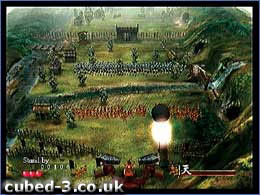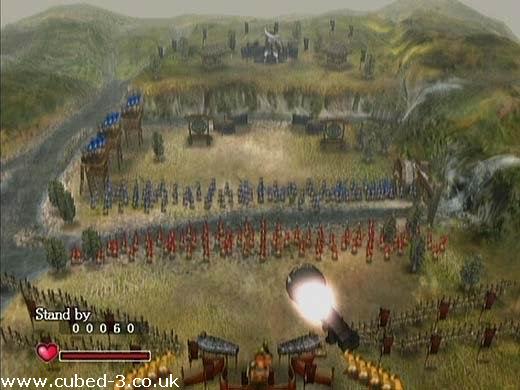Yoot Saito's Odama (GameCube) Review
By Mike Mason  17.06.2006
17.06.2006
Isn't it great when you get to see something that's different from everything else, a nice breath of fresh air, an entirely new scent, sensation or experience? They don't pop up too often, but it's fairly safe to say that Odama meets the criterion required to be a game-based manifestation of a unique experience. Ever seen real time strategy and pinball mixed together? Didn't think so.
It’s not the most natural mix of genres about – in fact, if you could pick two genres to mix, pinball and real time strategy would probably slot into the category of the ‘bizarre/unworkable’. Yoot Saito isn’t known for his willing to conform to traditional game making conventions, though, and so with Odama he has thrown caution to the wind and gone for it. The most surprising part is, it actually works to a fair degree most of the time.
Coming bundled with a microphone, the same one as used for Mario Party 6/7, the aim of the game is for your warriors to carry a giant bell from one end of the play field to another in order to take over an enemy’s land. The bell is carried by four large members of your army, and you can deploy smaller troops to back up, defend and attack for the bell-holders, as well as using them to take over parts of the board for your benefit. The microphone’s use comes into play when ordering about your troops – you clip it (quite securely, we might add) onto your Gamecube controller using a plastic clasp and slip the microphone into said clasp. To issue commands, players must speak/shout into the peripheral with pre-set phrases, which are taught to you over the course of several levels. With these voice commands learnt, you can influence the direction of your troops’ movement, whether they should attack or retreat, tell them where to focus their energies (for capturing or attacking purposes) or to perform contextual activities such as opening and closing a gate to control a river’s flow.

This still doesn’t explain where the pinball elements come in, so allow us to solve this puzzle. You are in possession of a giant metallic war weapon, the Odama, which is, simply, an enormous ball. To control this, you have two pinball-like flippers (controlled with your shoulder buttons) which knock it about, and the control stick is used to tilt the table to make it go where you want, hopefully flipping it over to weak points to cause massive damage to everybody opposing you. The problems with it are obvious – a metal ball isn’t going to discriminate against who it hurts, and so your soldiers are just as susceptible to harm as anything else in the arena, and, secondly, pinballs aren’t known for their predictability – this applies directly to an oversized one. If your Odama drops between your flippers, your own base will be totalled, meaning it’s a big fat loss for you.
This might sound like it’s going to require multi-tasking to the extreme to succeed impressively, and you’d be right. Anybody who thinks it sounds simple will be proven wrong and will be running themselves ragged trying to keep up with everything. As you’re trying to direct your soldiers to keep forward and keep rallying to take over an enemy flipper, you’re also trying to make sure there are enough of your men on the field to combat the flows of enemy troops, while making sure your Odama isn’t rolling through your men, hitting as much of your opponents’ property or people as possible, while searching for power ups to enable you to expand your army. The combination of voice control for your army, hand control for your weapon of mass destruction, constant thinking of what to do next and formulating stratagem make this a difficult game to play.

It has to be said that, though it’s brilliant to see such a strange mix of game types, Odama does not always live up to the concept in its implementation. For starters, the graphics make it difficult to see what you’re doing sometimes – they’re low polygon affairs, which is likely due to the speedy nature of the game, which makes detail on them sometimes hard to pluck out, and we lost many a game because we simply lost track of what was going on until it was too late. This was not entirely the visuals’ fault, but the fact that you’re often having to look just about everywhere on the screen at once to attempt to keep a hold on everything that is happening because of the multiple actions you’re commanding can be difficult, and the character representations do not help. That said, there are some nice looking effects that happen during play.
Another problem would be in the speech recognition. We all know that speech recognition in games isn’t yet up to scratch, and we’ve seen it fail in many a game. Fortunately, with it being such an integral part of gameplay, the microphone isn’t useless and commands are usually recognised, but it can be hard to retain a calm voice when scenes of utter chaos are unravelling before you, meaning orders have to be repeated a few times on occasion (“Rally. Rally! RALLY!” - repeat until exhaustion). Matches can be lost due to this, which can be very frustrating, but it’s somewhat understandable due to the volatile nature of voice recognition, what with everybody having different voice properties. It works most of the time, but in the moments when you need it most it can completely ignore you.

Odama is a hugely inventive game. As if the play mechanics already described weren’t enough, there are all manner of power-ups to be collected, our favourite being the one that makes your Odama light up neon green, allowing you to convert any opponents and put them into your reserve army stock for later deployment. Giant rice balls can also be fired from your end of the field, from the same catapult that launches the Odama, into enemies to distract them. Oh, and you have a time limit (when the time ends, the sun sets and further battle is deemed impossible) and your men have a morale metre (if it drops, they will complain and refuse to push forward against the enemy, etc.; going on strike is never the most intelligent thing to do in the middle of battle, but what can you do?) – both of these can be topped up, but only with crafty play and luck of getting good power-ups.
This last use of phrase highlights a problem though. Due to the unpredictable nature of the Odama, which even the tilt cannot sometimes solve, much of gameplay relies on pure luck. You could be playing your best game ever, nearly at the end, many enemies vanquished, but if you let your guard slip for a moment or you lose co-ordination for a second, your Odama could smash its way down the board and through your own flippers for an instant defeat just moment away from your own victory. Other times, you might lose just a few seconds in because of this, or you might squash/drown/otherwise kill your men by accident. Skill and luck contradict each other much of time and can be infuriating.
A special mention must be given to the announcing during the game. All in native Japanese and subtitled at the bottom, it is fantastic, adorning the player with encouragement, sarcasm, praise and sorrow in equal portions and is a fitting follow-up to the voice work employed in Saito’s previous title, Seaman on Dreamcast. Otherwise, Odama succeeds in many respects, bursting with imagination, using effective physics, but doesn’t do quite so well in others, not all concepts coming off as well as they should or feeling compromised. It must be told that the game is addictive, often tempting you back for another go despite your frustrations, so it must do something right.

Cubed3 Rating
Very Good - Bronze Award

You can get Odama for £19.99 from Gamestation now, after it bombed for full price. For this much, it’s well worth picking up one of the most inventive games in the current generation – one that, although it doesn’t meet all targets it probably set out to hit, is definitely worth a play if only to see that game developers aren’t running out of ideas and new ones are still appearing. With adjustments to how much skill is required and better voice recognition, Odama could have been a much better game, but as it stands it is more than passable. Just keep your eye on the ball…

![]() 7/10
7/10
![]() 10/10
(2 Votes)
10/10
(2 Votes)
 Out now
Out now  Out now
Out now  Out now
Out now  Out now
Out now Comments
Comments are currently disabled

 Sign In
Sign In Game Details
Game Details Subscribe to this topic
Subscribe to this topic Features
Features





 Top
Top

